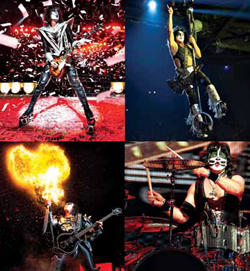
Paying Respect
Just like the band’s music, KISS’ use of pyrotechnics on The Tour was in-your-face, replete with the giant shower of sparks and stars.
Certainly not without its share of things that flash and go boom, the Crüe show differed in that it relied more heavily on flames to create ambience and atmospherics.
“KISS has been around for nearly 40 years,” notes Casey Lake of Albuquerque, New Mexico-based Stage & Effects Engineering. “It’s a venerable act with long-established cues for pyro. When Paul Stanley raises his guitar at the end of ‘Love Gun’ and acts like he’s shooting into the trusses, the fans expect to see us send a perfectly timed volley of pyro through the air in response.
“No one should attempt to change that, or any of the other fiery standards seen in the show. The challenge for us this time out was to pay respect to what’s been established while still coming up with colorful effects that haven’t been seen.”
Electronically fired using a proprietary system called Pyrodigital, over 1,000 pyro effects were shot for both KISS and Mötley Crüe, with the former using 750 of those alone. Flame systems, on the other hand, were managed with a little help from a Leprecon DMX console, a control and dimming surface commonly used by lighting crews.
Guided by a philosophy of bigger, more, and then a lot more, the pyro crew drew from an artistic palette including comets, gerbs, airbursts, and concussion shells, all of which were inventoried in a galaxy of colors ranging from red, white, and blue to aqua and vivid purples.
Comets are charges packed into tubes measuring three inches high at the most. Think of a roman candle at your dusty roadside fireworks stand, only not as big and capable of shooting multiple volleys that look like tracer rounds fired from a machine gun.
Meanwhile, gerbs are the fountain effects you see emitting a shower of colored sparks, frequently silver. Airbursts are devices that hang from the trusses resembling a tightly-wrapped baggie the size of a walnut. Ignite one and it produces a 10-foot burst of colored sparks similar in appearance to an aerial fireworks shell going off on the Fourth of July. Concussion shells are pure, unadulterated noise heard at nothing-pretty-about-it KA-BOOM levels that usually go off upstage with thundering impact.

The main explosive ingredient found in these effects is nitrocellulose, a compound embraced by the pyro community because of its low smoke content.
Pulling Out The Stops
The most intense pyro during either act was the KISS finale, which literally painted the entire environment with a nuclear intensity. Choreographed to the anthemic blare of “Rock All Night,” the show-closer utilized every device the pyro truck could hold, plus all the tricks the crew could conjure.
Copiously deployed gerbs were one finale highlight. In one application, the devices were attached to mechanical spinners staked-down at drummer Eric Singer’s riser. Set into motion on cue, the spinners sent showers of sparks all across the stage and into the air above the audience.
Descending into the valley of flames which marked the Mötley Crüe show, Stage & Effects Engineering brought its own burn bars and propane heads to the pyro mix, both of which saw action as scenic backdrops and as the direct sources of blazing downstage drama.
“It’s easy to get lost in the impact of the pyro and all the flames in a show like this,” Lake explains. “But for us the important overriding factor in everything we did was safety. Our pyro devices were all manufactured to strict specs for indoor use. As for our flame systems, our propane heads were each equipped with a valve to control height. That made it easy for us to regulate the size of our flames without having to rely on maintaining a certain amount of pressure in our tanks.
“If something went wrong, we would have seen it instantly and could’ve reacted to shut things down just as fast, or the systems would have turned themselves off. We made things across the board so that everyone was always kept out of harm’s way, all while we gained a little more power artistically too.”
Gregory A. DeTogne is a writer and editor who has served the pro audio industry for the past 30 years.
